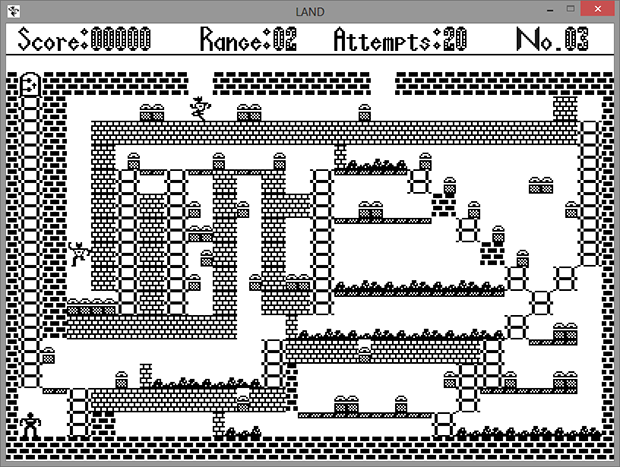Game “LAND” for DVK-3. Windows Reincarnation

Back in 1988, when I was a sixth grader, I first became acquainted with a computer. Those who do not know ─ it was a DVK-3M with an integrated black and white display and two five-inch drives. But now is not about him. My first acquaintance took place with games from ASP corp. ─ three children-programmers who specialized in computers of the DVK family .
Some enterprising people set up a pair of DCK-3M in our school and fixed a tariff of 1 Soviet ruble for 1 game hour. We saved on lunches, and some people begged for money from their parents to play after classes in Star Patrol, Tetris, Zona, Cat, Garden, Sheriff and of course LAND! Since then, I have sentimental feelings for everything connected with those games and computers, just like John Connor to the Terminator of the first model.
')
Especially popular was the game LAND. It was such a version of Lode Runner, but we were delighted! Many years have passed, these computers are hopelessly outdated and no longer occur in nature, but nostalgic feelings periodically made themselves felt and there was a desire to remember childhood and play.
The goal of the LAND game is to collect all the chests at this level and get to the door to the next level. Beware of demons and biomass. You can run, climb ladders, destroy brick walls, shooting at them. Note that destroyed bricks are restored with time. Demons cannot be killed. If the demon is dying from biomass, a new one appears at the top of the screen.
The idea of making the Windows version visited me quite a long time and repeatedly, but somehow it didn’t get around. In the end, I firmly decided to make it happen, and the first thing I did ─ I tried to contact the authors of the game, hoping to get at least the sprites and timings of all the actors. I managed to get in touch with habraiser Alexander Grechishkin , the author of the game, but, unfortunately, no source code has been preserved. The game was written in 1986 in assembler, so even the presence of source codes would hardly help me. I want to warn in advance that I will not go deep into technical details further.
After some thought, I decided to take screenshots from the UKSC center emulator (the Soviet microcomputer compatible with DVK), independently cut the sprites and transfer the game levels manually, drawing them in a text editor.
As a platform for the development of the game was chosen XNA framework 4.0. It is no secret that Microsoft refused to further develop this framework, but its open source implementation MonoGame lives and thrives. I'd add from myself that despite some minor errors in MonoGame, in 10 minutes I successfully transferred the project from XNA to MonoGame. Also, XNA was a very simple and understandable thing, as far as 2D is concerned.
I processed screenshots from the emulator in Photoshop, increasing the chopped material 2 times. The project contains 2 sets of identical sprites, under a white and black background, as was done in the original game.
Location maps are an array of 50 x 16 familiarity. All maps are stored in text files and, if necessary, can be edited in a text editor with a font of fixed width. I also added the ability to independently generate my own sets of cards and connect them to the game. To do this, you need to create your own bank of maps in the Content / Maps folder and fill it with cards according to a template from the map.template file, which is located there. The game includes 2 sets of maps from the original games that are found on the Internet.
In fact, the whole game is a display of a time-varying copy of the level array, and the actors — room, biomass, demons, bullet, and hero — affect the state of this array. Independently, only demons, bullet and hero move.
I had to pick the actors' timings manually, by eye. But it turned out quite close to the original.
Management is simple, as in all similar games:
- Cursor keys - movement of the hero;
- Z, X - shot left and right;
- Q - start the game from the beginning;
- R - start the level from the beginning with the loss of one life;
- ; - next level;
- F10 - switch to the next set of cards;
- F12 is a full screen game;
Gameplay video
Source codes can be found on github or download the installer with the compiled game ( please do not quibble with the source codes, it was written Just4Fun ).
Well, now I invite everyone to feel nostalgic with me.
Source: https://habr.com/ru/post/223387/
All Articles